
The Dallas Ambush: One Year Later
Remembering the deadliest day for police since 9/11.
- By Sydny Shepard
- Jul 07, 2017
I’m not sure if you know this or not, but the majority of the Security Today team is based out of Dallas. Me, personally, I’ve lived in Dallas for over half my life. If someone asks where “home” is, my answer is Dallas.
I don’t have to tell you about how the Dallas ambush affected me, this town, our police or the security of the city, state and nation. You saw it play out on national television. You listened to news anchors try to explain the inexpiable. How Micah Johnson drove into downtown Dallas with the sole intent to shoot and kill as many police officers as possible. Unfortunately, five heroes did not survive the night making it the deadliest night for law enforcement since September 11, 2001.
July 7, 2016
The shooting happened in downtown Dallas, on the metaphorical front steps of El Centro Community College, making the school the stage for such a heinous act. At first, the information coming out of the scene was chaotic and unfathomable. News stations around the county were trying to decipher the misinformation and hectic live footage coming out of the Texas city.
The streets that night were filled by protesters taking part in a peaceful protest against police in the shootings of several black men in the United States in 2016 and before. Dallas Police had posted photos on their social media pages of officers engaging with protesters, flanking them as they walked with each other, protecting their right to freedom of speech.
When the shots rang out on the corner of North Lamar and Elm Street the headlines read, “Shooting at Dallas Protest.”
There wasn’t a news station in the country that believed this was a targeted attack on police officers until former Dallas Police Chief David Brown gave his first press conference just a short time after the first shots were heard.
“The suspect has told our negotiators that the ‘end is coming’ and that he is going to hurt and kill more of us, meaning law enforcement,” Brown said at the press conference. “We will work tirelessly until we figure out what motivated this attack on our officers.”
The numbers were high: nine officers shot and five dead. By the end of the night, four Dallas Police officers and a DART officer would be identified as those deceased.
Those investigating the case would never get a straight answer on the motivation for the attack as Johnson would not make it to the morning alive. Officers attempted to negotiate a peaceful surrender with Johnson, but he disregarded their attempts to end the standoff saying he’d only negotiate with “black officers.”
Brown told reporters they’d tried to negotiate with Johnson for over two hours, but when it seemed clear he would not negotiate further they made the decision to use a bomb disposal remote control vehicle armed with about one pound of C-4 explosive. Johnson saw the robot coming towards him and shot at it several times before it exploded, killing him.
The Aftermath
As a result of the shooting, local law enforcement officers worked more than $800,000 in overtime to help the Dallas Police Department. This included $86,000 spent by the Dallas County Sheriff's Office, $88,000 spent by the Arlington Police Department, about $705,250 by DPD, and unknown sums by the Irving Police Department and the Dallas Fire-Rescue Department.
The shooting on DPD and DART officers as well as the shooting, just one week later in Baton Rouge, Louisiana that would take the lives of three police officers, would force agencies to reevaluate how to protect their officers. Patrol cars were filled with teams of two as officers were paired together for security.
Law enforcement across the country would begin to readjust response strategies as well as increased security and surveillance at protesting events against the police. Governor Greg Abbot would later inform DPD that they had received a $1 million grant from Homeland Security for protective gear.
In the months leading up to the shooting, local police departments, including DPD, had been struggling to hire new recruits and retain old ones due to low salaries. Within 12 days of the shooting, DPD received 467 job applications, representing a 344% hike from the 136 applications received by the department in June of 2016.
Most contribute this increase to Brown when he brazenly asked those who protest the police to join them.
“We’re asking cops to do too much in this country,” Brown said. “If anything can be done, it needs to be done by the public, which includes the protesters. Don’t be a part of the problem. We’re hiring. Get out of the protest line and fill out an application.”
Remembering Those Fallen One Year Later
DPD Senior Cpl. Lorne Ahrens, 48, had been with the department since 2002.
DPD Officer Michael Krol, 40, had been with the department since 2007.
DPD Sgt. Michael Smith, 55, former Army Ranger, had been with the department since 1989.
DART Officer Brent Thompson, 43, a former Marine, had been with the department since 2009.
DPD Officer Patricio “Patrick” Zamarripa, 35, former Navy sailor and Iraq war veteran, had been with the department since 2011.